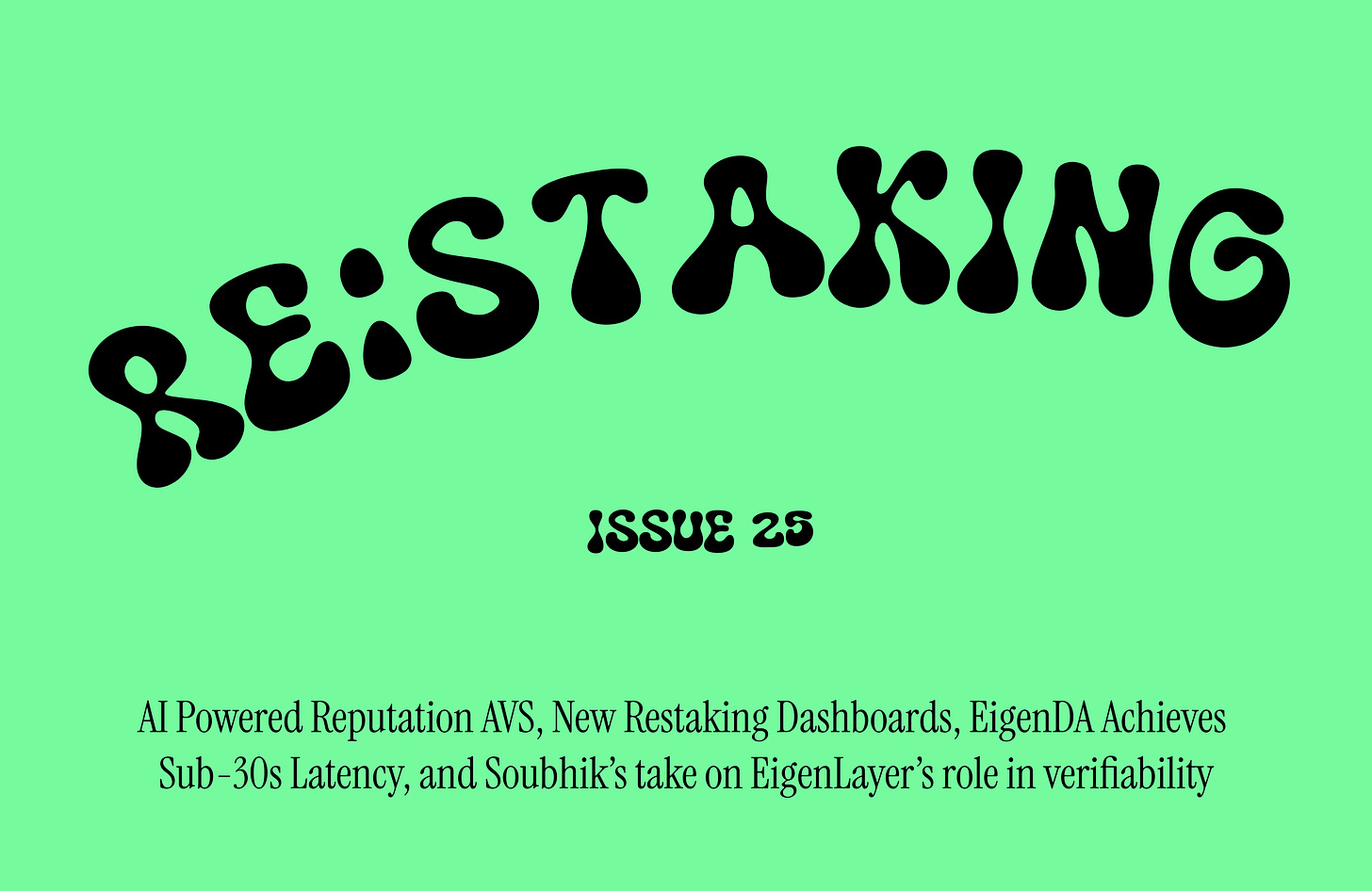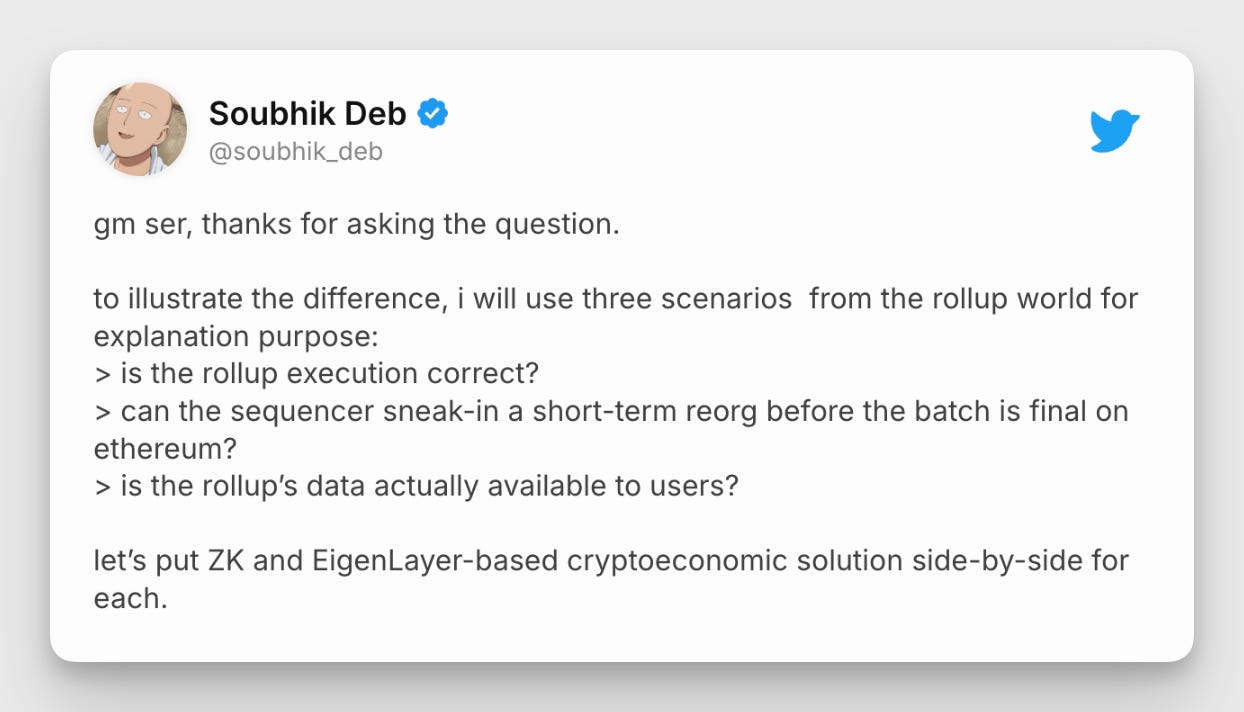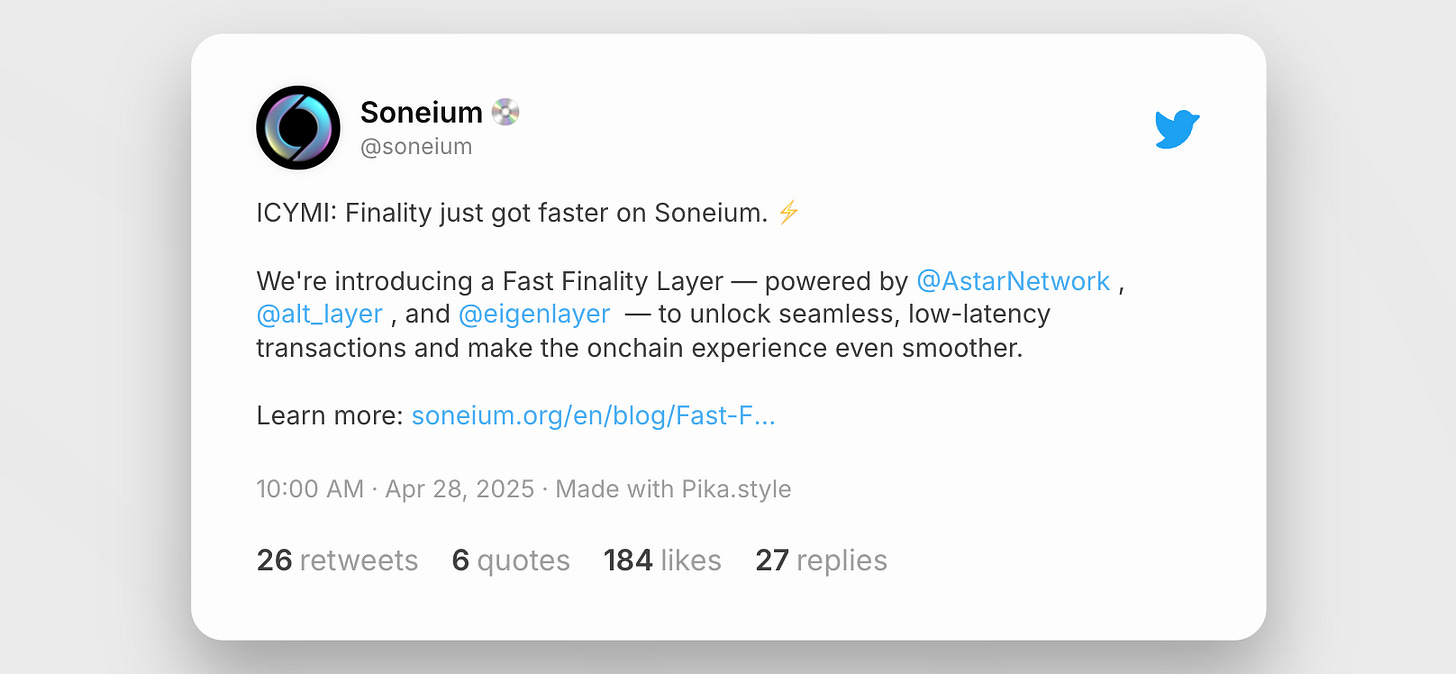Re:Staking Weekly #25
AI Powered Reputation AVS, New Restaking Dashboards, EigenDA Achieves Sub-30s Latency, and Soubhik’s take on EigenLayer’s role in verifiability
Welcome to Issue #25 of Re:Staking Weekly! 👋
This week, we sat down with Zeru Finance CEO Ashutosh to explore a fresh approach to onchain reputation—one that stands in contrast to Predicate, the AVS known for its programmable and objective transaction policies. Zeru takes a different path, leveraging AI models trained on both onchain and offchain data to derive user behavior scores. Their broader vision? A decentralized network of community-trained AI reputation agents. It’ll be fascinating to watch how these two models evolve and diverge.
Also in this issue:
Two new restaking dashboards
EigenDA achieves sub-30s latency
Soubhik’s take on EigenLayer’s role in verifiability
Kelp DAO’s smart contract bug
… and more
Let’s go! 🚀
AI Powered Reputation AVS — Zeru Finance
We’ve covered Predicate before — the AVS building programmable, expressive transaction policies with institutional-grade data feeds. It empowers protocols to define their own rules and interpret data however they see fit.
Zeru, by contrast, takes a more opinionated route to solving a similar problem: how can we make trust programmable?
Rather than offer modular tools for interpreting data, Zeru aggregates a broad set of signals — onchain and off — and feeds them into a behavior-centric AI model that outputs a Zcore, a standardized reputation score. The end goal is to make this score useful for everything from undercollateralized lending to employment verification.
The approach is ambitious and certainly comes with its challenges. Here’s a breakdown of our discussion with Ashutosh, Zeru’s CEO, about the project’s architecture, tradeoffs, and open questions.
1. Beyond On-Chain Data
At the foundation of Zeru’s model is a structured view of what constitutes reputation. Instead of focusing solely on wallet activity or DeFi interactions, it defines five distinct paradigms:
Financial: credit scores, bank account details, asset ownership
Societal: user ratings (Uber, Airbnb), social media engagement
Identity: KYC/KYB status, biometric or decentralized identity
Professional: employment history, academic credentials
Onchain behavior: DAO voting, lending history, restaking activity
This model aims to capture a broader and more holistic view of a user’s track record. It borrows heavily from how risk is measured in traditional industries, bringing that logic into the crypto-native world.
Rather than trying to compress everything into one number, Zeru is building a modular scoring framework — one that protocols can query for different dimensions of trust depending on their needs. While ambitious, the model remains grounded in pragmatic composability.
2. A Neural Network That Scores You
Whereas Predicate leaves policy logic entirely in the hands of the client, Zeru chooses to standardize its approach. It uses a neural network trained on behavioral data to derive a probabilistic score — one that reflects not just what users have done, but how they’ve behaved over time across multiple vectors. The model can identify traits like risk-seeking or conservatism, and surface signals that might not be obvious from raw onchain data.
Zeru positions this not as a fixed “credit score” but as a flexible reputation profile. The Zcore is just one dimension — protocols can also query specific attributes that may be more relevant for their context. This setup allows for standardization without sacrificing adaptability.
3. Turning Scoring into a Game: Competing Agents for Reputation Models
Zeru’s V2 introduces a layer of decentralization in how reputation models are constructed and evaluated. The system will feature scoring agents — independently developed models, either by the Zeru team or community contributors, each trained on different behavioral assumptions.
These agents will compete in a live environment, with rewards going to those whose models most accurately predict real-world outcomes like defaults or protocol retention. End users or applications can choose which agents to trust, effectively creating a market for reputation logic.
This framework reduces the risk of a single, biased definition of what "good behavior" looks like. It turns scoring itself into a competitive process, allowing new approaches to be tested and validated over time.
4. Breaking the Adoption Barrier: Focused Use Cases and Revenue Model
While Zeru’s architecture is thoughtful, the bigger challenge lies in adoption. The onchain reputation space is littered with projects that had technically sound designs but failed to gain meaningful integration.
Zeru is aware of this, and is focusing its go-to-market strategy around concrete, high-friction use cases: employment verification, undercollateralized lending, and vendor reputation. These are categories where trust matters, and where reputation-based decision-making is already part of the workflow — even if it’s currently slow, opaque, or expensive.
The monetization model is SaaS-based: API calls for reputation queries, and per-verification fees for enterprise use cases. The goal is to offer both cost and speed advantages over traditional verification systems while maintaining trust through decentralized validation.
Zeru is already in conversations with early clients, and building out the infrastructure required to support real integrations. Their success will hinge not just on how accurate the Zcore is, but whether it can reduce risk or unlock access in ways that protocols or employers find meaningful.
Zeru presents a compelling alternative to the current simple, centralized identity and reputation services in crypto. Rather than relying on one-off heuristics or simplistic scoring models, it offers a layered framework for quantifying behavior and surfacing trust — while still allowing for subjectivity and evolution through scoring agents. The ultimate goal, of course, is to package trust into programmable, composable, and context-aware product — without sacrificing fairness or neutrality. Whether that vision takes root will depend less on the strength of the model itself, and more on whether protocols and institutions decide they need what Zeru is offering.
Read more
News Bites
a41, an institutional staking provider, launches the restaking.risk Dashboard — offering expanded categorization and in-depth analysis of individual AVS architectures and their security features.
EigenDA V2 reduces blob commitment latency from 10 minutes to 30 seconds, with plans to bring it down to 10 seconds soon.
EigenExplorer launches V2 of the EigenLayer AVS dashboard, featuring new tools like rewards analytics and portfolio tracking.
Read Soubhik’s take on how EigenLayer represents the crucial second half of the verifiability landscape — securing programmable verifiability through economic guarantees, in contrast to the mathematical verifiability offered by ZK.
Transaction speed and verifiability are the mid-term endgame for the Ethereum ecosystem — and everything seems to be converging toward that over the next year. The dots are connecting…
If you're restaked in Kelp, note that a bug in the minter contract has been identified. As a result, deposits and withdrawals are currently paused. Stay tuned for updates and review your positions accordingly.
You can now explore and ask about EigenLayer’s documentation, smart contracts, and Hello World reference architecture through the DeepWiki interface.
Quote to ponder: "Verifiability of both data and execution is the foundation of a trustworthy and efficient financial system."
EigenFoundation introduces the Grants Oversight Council to formally guide capital allocation and support ecosystem growth.
We’ve covered it before, but Soneium (Sony’s blockchain) has just released more details on its Fast Finality Layer — leveraging AltLayer and EigenLayer’s restaking mechanism.
That's it for this week's newsletter! As always, feel free to send us a DM or comment directly below with your thoughts or questions.
If you want to catch up with the latest news in the restaking world, give our curated X list a follow!
See you next week and thanks for reading,











